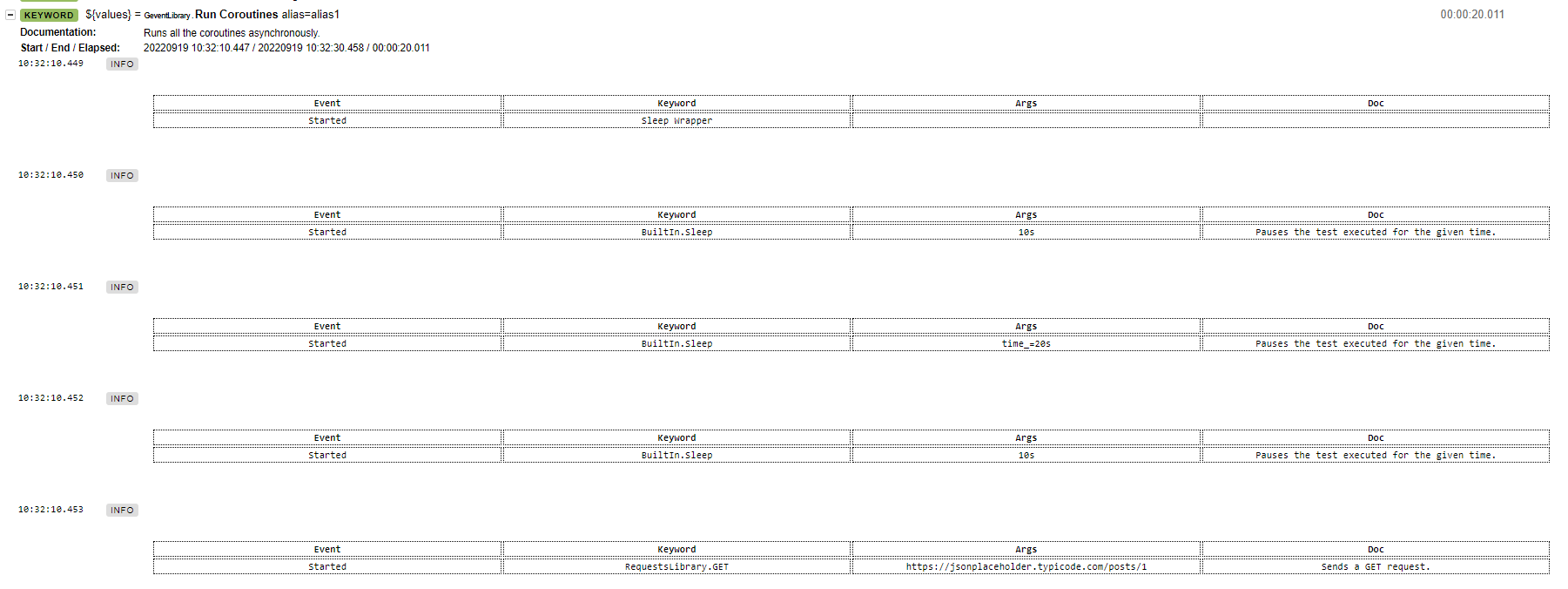Run keywords asynchronously with the power of gevent
pip install robotframework-gevent# simple-test.robot
*** Settings ***
Library Collections
Library String
Library GeventLibrary
Library RequestsLibrary
*** Test Cases ***
Test1
[Documentation] Simple test flow with gevent greenlets
Log Hello World
Create Gevent Bundle alias=alias1 # Create a bundle of coroutines
Sleep 10s alias=alias1 # run your synchronous keyword
# register all your keywords as coroutines to the gevent bundle
Add Coroutine Sleep Wrapper alias=alias1
Add Coroutine Sleep 20s alias=alias1
Add Coroutine Sleep 10s alias=alias1
Add Coroutine GET https://jsonplaceholder.typicode.com/posts/1 alias=alias1
Add Coroutine Convert To Lower Case UPPER
# Run your coroutines and get the values by order
${values} Run Coroutines alias=alias1
Log Many @{values}
# The 3rd coroutine was a request, take it's value
${jsonplaceholder_resp} Get From List ${values} 3
# assert the returned response code to be 200
Status Should Be 200 ${jsonplaceholder_resp}
# assert that the returned `userId` field equals to 1
Should Be Equal As Strings 1 ${jsonplaceholder_resp.json()['userId']}
*** Keywords ***
Sleep Wrapper
Sleep 1s
See - Keyword Documentation
>>> robot simple-test.robot
After test is completed go to log.html:
Owing to the fact that keywords are executed asynchronously, we cannot know the order of keyword execution, so instead they are printed in a table format
go to examples
Modern software architecture is event driven, with many background process.
Servers are being more pro-active instead of re-active as we see in a client server architecture.
In order to test such systems, we need the ability to run coroutines in our test scripts.
With the power of gevent, we can run several coroutines in greenlets, so integrating them into our robotframework test script will provide super powers to our testing efforts!
Concurrency can be achieved in 3 different ways:
-
Multiprocessing - running each task in it's own
process. The cons of such an approach would be massive consumption of resources, namely CPU and memory, as this means to allocate an entirememory heapto each task. Another problem is a possible need forInter-Process Communication (IPC)that might be costly. -
Multithreading - running each task in a
thread. Unlike multiprocessing, now all tasks run on the same memory heap and separated by threads, which the CPU coordinates usinground-robin. However, python'sGlobal Interpreter Lock(GIL) prevents these threads from acting concurrently, it might perform context switching when IO operation occurs but there's no control for that. -
Asynchronous IO - running all tasks on a single thread, while IO operations won't block the progress of the program, while code execution is committed by an
event loopthatselectsbetween attachedcoroutines. This is highly efficient in resources consumption when compared to multithreading and multiprocessing, but it requires some modifications to the original code.BlockingIO statements can hog the event loop and the code will not be concurrent.geventallows programmers to write seemingly regular "blocking" python code, but it will enforce asynchronous IO compliance bymonkey patching
| LICENSE
| .gitignore
| .pylintrc
| pyproject.toml
| poetry.lock
| README.md
|
+---src
| \---GeventLibrary
| | \---exceptions
| | | __init__.py
| | \---keywords
| | | __init__.py
| | | gevent_keywords.py
| | __init__.py
| | gevent_library.py
|
+---atests
| | __init__.robot
| | simple-test.robot
| |
| \---utests
| | __init__.py
| | test_bundle_creation.py
black used for auto-formatting code read,
pylint used for code linting and pep8 compliance read,
mypy used for type hinting read,
robocop static code analyzer for robotframework read,
perflint pylint extension for performance linting read
cosmic-ray Python tool for mutation testing read
Thanks goes to these wonderful people (emoji key):
MalikMlitat 📖 |
This project follows the all-contributors specification. Contributions of any kind welcome!



